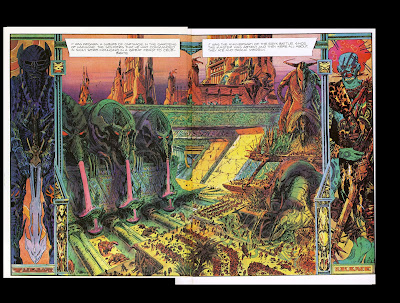'The Weird World of Eerie Publications' by Mike Howlett
Feral House, 2010
As a kid growing up in the late 1960s and early 1970s, the most depraved, tasteless, gruesome, schlockiest, and horrifying comics that I could find were the black and white comic magazines issued by Eerie Publications.
Now, however bizarre and unlikely it may seem, comes a real treat for anyone interested in those comics, or sci-fi and horror pop culture in general: a coffee table book devoted to Eerie comics !
'The Weird World of Eerie Publications' (Feral House, 2010) is a large (8" x 11"), handsomely produced hardbound book, the 310 pages of which cover everything you'd want to know about the Eerie Empire.
(The one thing the book doesn't do is reprint any stories in their entirety; for that, you will want to check out the 2007 trade paperback 'The Zombie Factory' by Patrick O'Donnell).
Given titles like Tales of Voodoo, Weird, and Horror Tales, the Eerie comics featured garish cover illustrations that were the antithesis of the artful covers on the Warren horror magazines.
The contents of these books were always chock full of gore in ways that few, if any, horror comics since have equaled.

The Eerie comics were produced from 1966 to 1981 by Countrywide Publications, whose publisher, Myron Fass, earned a considerable income from churning out low-budget, limited-run magazines (sometimes as many as 50 a month). These magazines were generated by underpaid, ambitious young writers determined to break into the business, and relied on illustrations obtained from studio-provided, public-domain, and archival photograph libraries.
The Eerie line was edited by Carl Burgos, who was the creator of the Human Torch for Timely (later Atlas / Marvel) comics in the Fall of 1939. In contrast to the approach taken by Warren, DC, and Marvel, neither Fass nor Burgos gave much attention to showcasing the writers and authors who contributed to their magazines. And while not all the strips that appeared in the Eerie comics were necessarily top-notch, many were of a quality equal to that of the Warren publications.
Dick Ayers, Chic Stone, Bill Alexander, Cirilo Munoz, Hector Castellon, and many other artists could produce well-crafted material, albeit of a gruesome nature.
Ayers, in particular, was fond of drawing dislocated eyeballs dangling from the optic nerve on the heads of his victims:

'The Weird World' opens with a brief recitation of the history of the horror comic books, which is where Fass and many of the Eerie artists cut their teeth, so to speak. Subsequent chapters provide a overview of the Eerie titles issued from 1966 to 1981, the one-shot miscellaneous horror and crime magazines that popped up in later years, and the other sleaze titles (the shark magazines in particular were genuine trash) that Fass and company churned out in the 80s.
Howlett was able to interview former employees from Countrywide and Eerie, and they provide some interesting insights into the world of schlock publishing. Like any true schlock producer, Fass was adamant about recycling covers and interior content, was late in paying contributors (sometimes shafting them of their pay entirely), and had no qualms about how to make a buck (although Fass and the majority of the Countrywide staffers were Jewish, he regularly ran advertisements for companies selling Nazi memorabilia).
The book's second half provides overviews of the Eerie artists and writers, who are now, some 40 years later, starting to receive attention for their demented genius in creating some of the most jolting stuff to appear in mainstream horror media.
The last few chapters provide a gallery of all the Eerie comic covers, and a rather hastily drawn 6-page comic specially written for the book by Eerie alum Dick Ayers.
At a price of $21.75 (not including shipping) at amazon.com, 'The Weird World' is very affordable and you get a lot of value for your money. This is a must-have for all fans of Eerie comics and the horror comics culture at large.

















































































